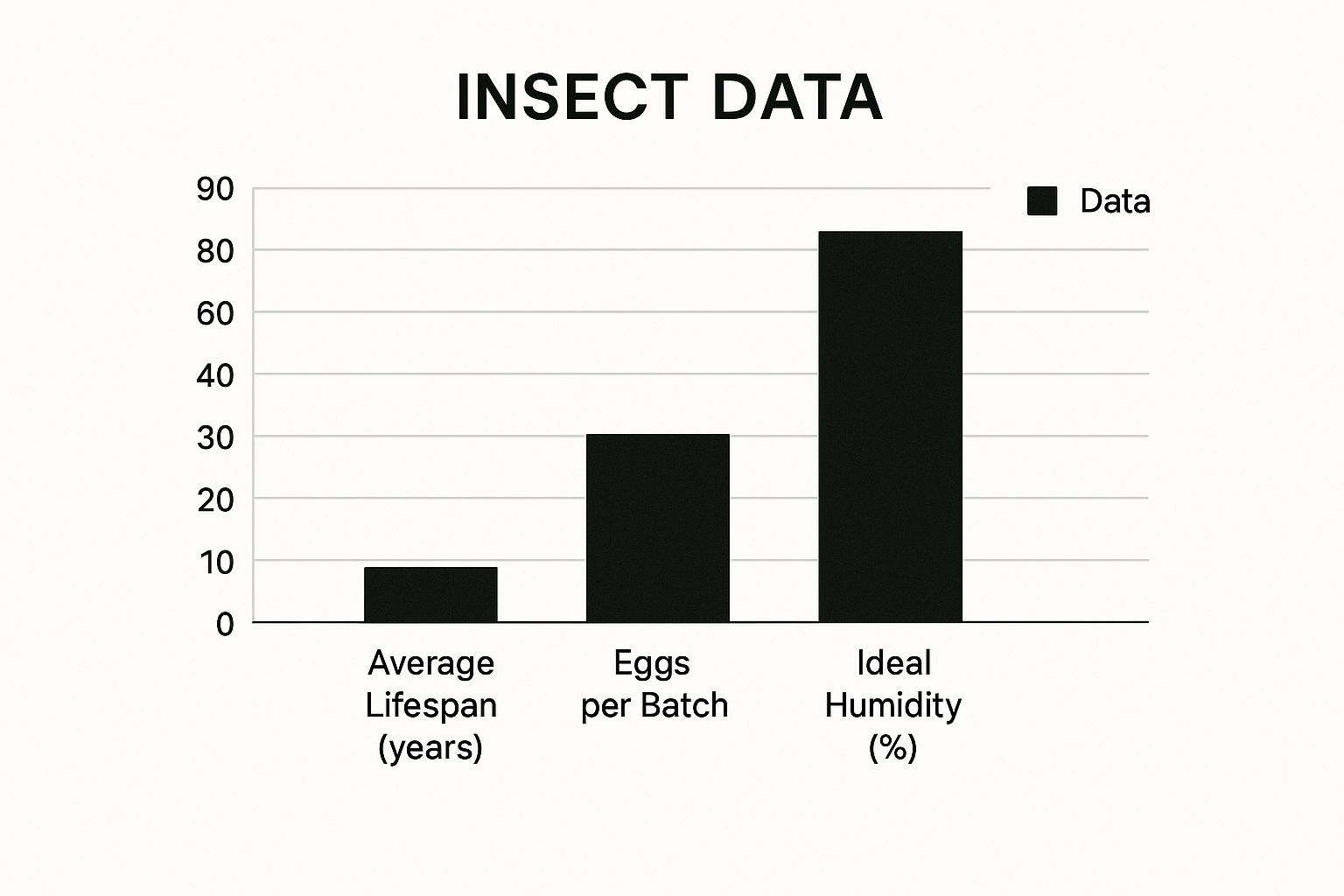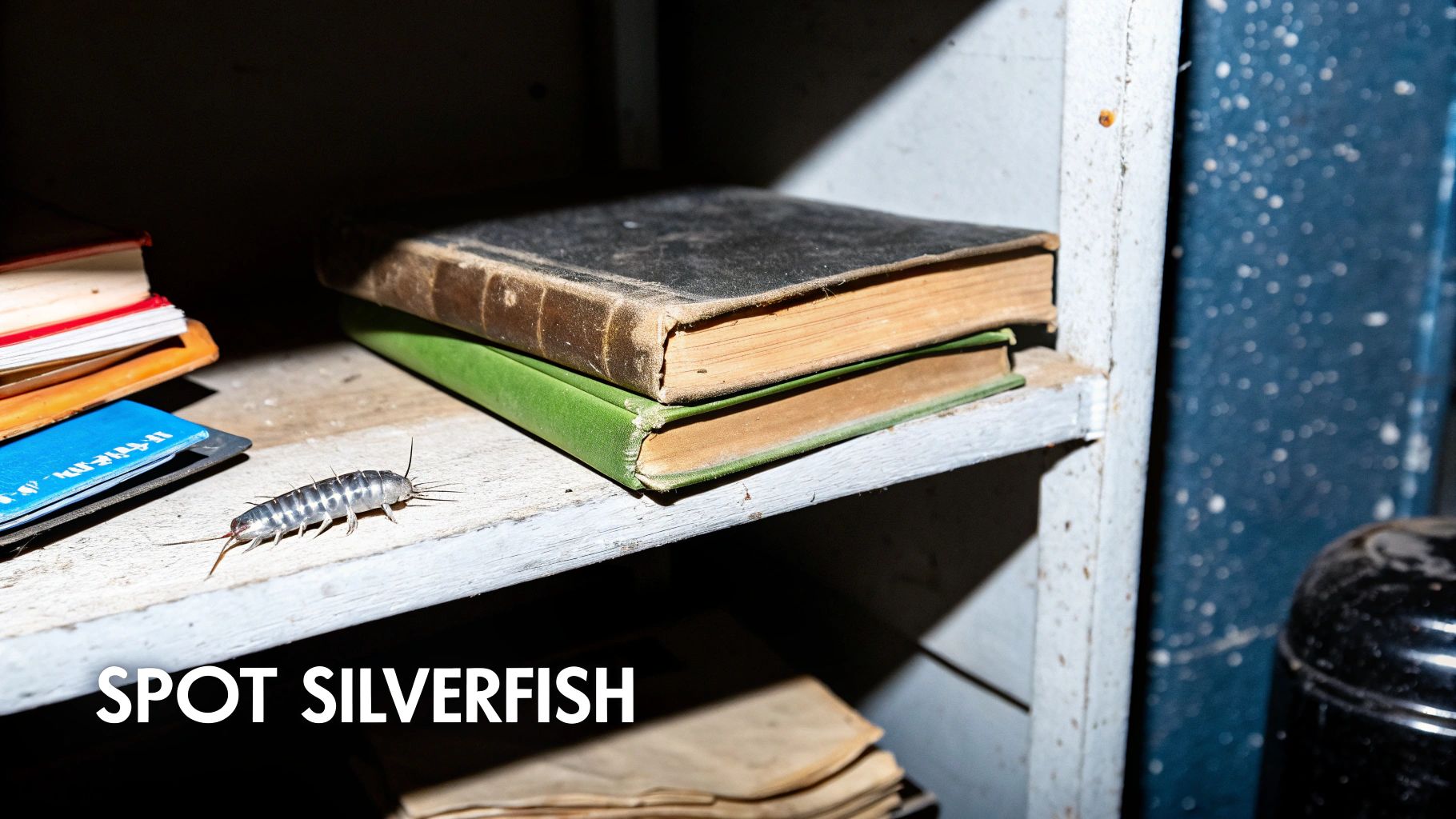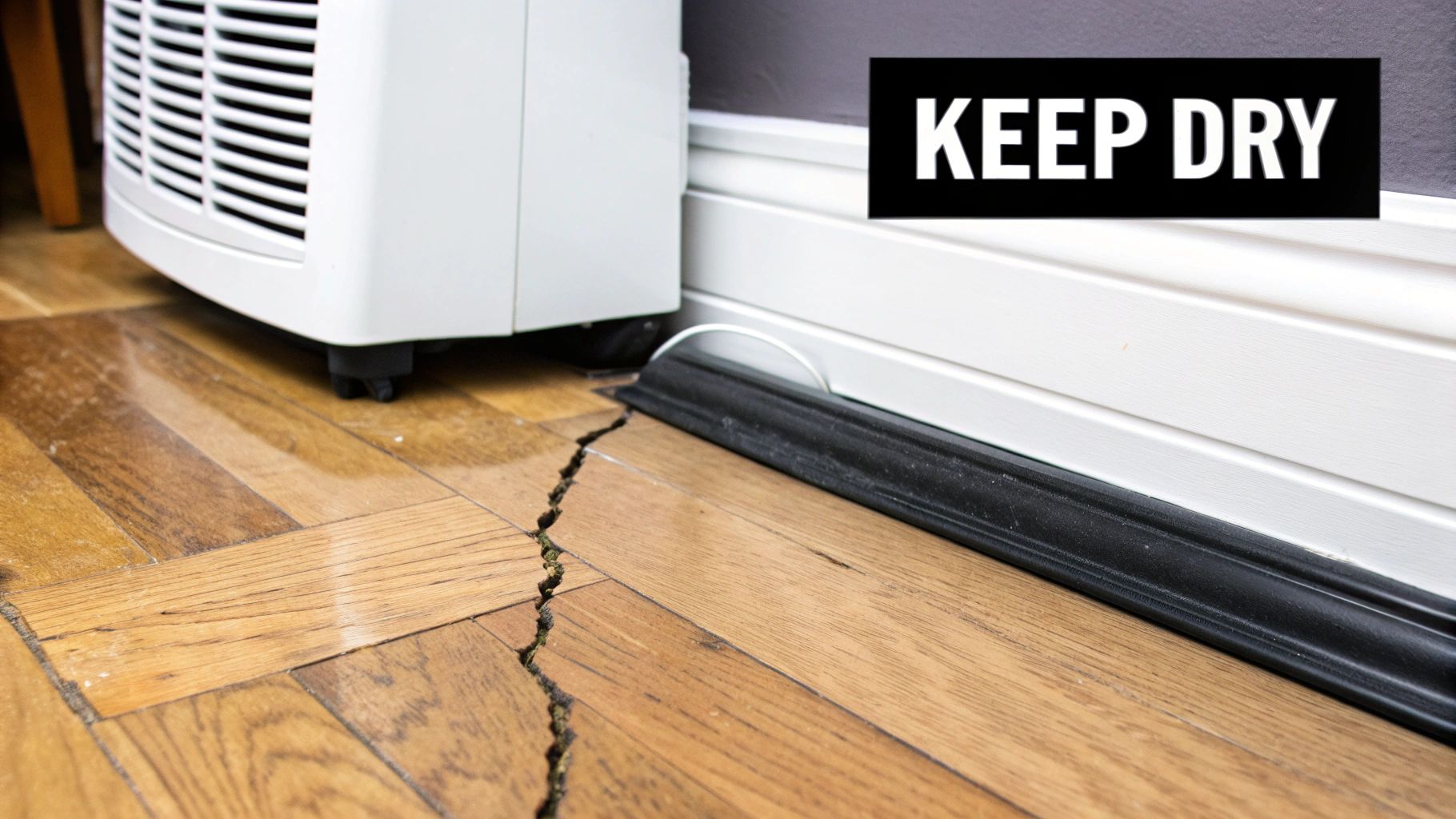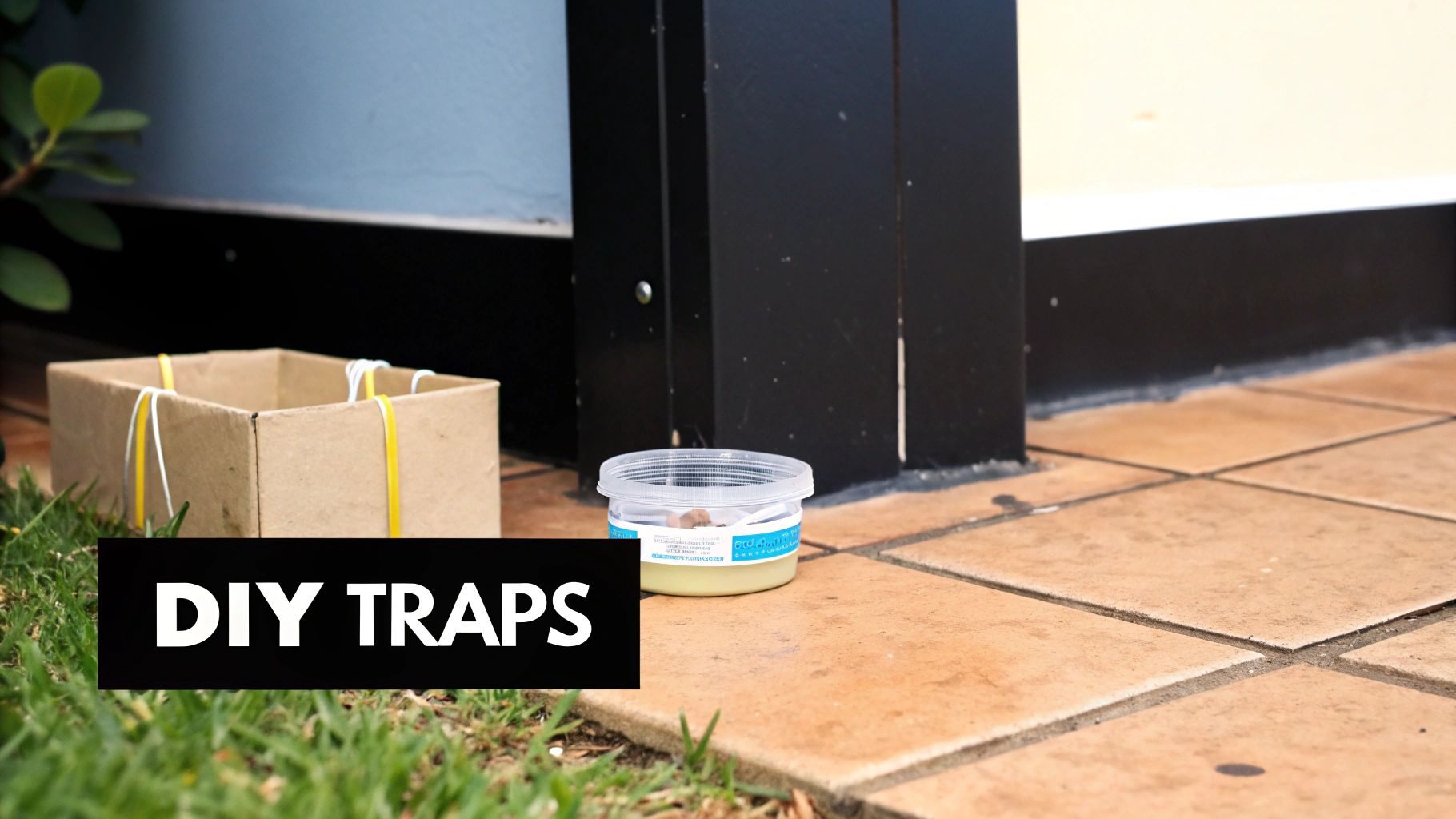It’s often the small, easily-missed clues that signal a silverfish problem. You might spot faint yellow stains on a bookshelf or find tiny, odd-shaped holes in your wallpaper. Catching these early signs is crucial if you want to prevent serious damage to your books, fabrics, and home décor.
How to Recognise a Silverfish Infestation
Most people only realise they have a silverfish problem after the damage is already done. But if you know what you’re looking for—and where—you can catch them before they get properly settled in.
Keep an eye out for these tell-tale signs, which often appear long before you ever see an actual silverfish:
- Faint yellow stains on shelves, in drawers, or near skirting boards. These are often their droppings.
- Tiny, irregular holes nibbled into wallpaper, book bindings, or even cardboard boxes.
- Shed skins left behind in dark corners and crevices after they moult.
Where Do Silverfish Hide?
Silverfish are shy creatures that thrive in dark, damp places. Think about the areas in your home with persistent moisture: behind the toilet cistern, in the corners of your loft under the eaves, or deep inside kitchen cupboards. If you see damage in these spots, it’s a safe bet that silverfish have been active for some time.
This visual guide breaks down three key facts about silverfish that explain why they can become such a persistent issue.

The numbers speak for themselves: with an average lifespan of 5 years, laying 40 eggs at a time, and thriving in 85% humidity, you can see how a damp environment can quickly lead to a population explosion.
Common vs. Grey Silverfish: Knowing Your Enemy
Figuring out which species you're dealing with is a big step towards getting rid of them for good. In the UK, you're most likely to encounter one of two types.
UK Silverfish Species: A Quick Comparison
This table breaks down the key differences between the Common Silverfish and its tougher cousin, the Grey Silverfish.
| Feature | Common Silverfish (Lepisma saccharina) | Grey Silverfish (Ctenolepisma longicaudata) |
|---|---|---|
| Body Colour | Bright, silvery sheen | Dull, matte grey finish |
| Humidity Preference | Needs high humidity, around 70% RH | More adaptable, comfortable at 55–60% RH |
| Typical Location | Bathrooms, cellars, damp storage areas | Can be found almost anywhere indoors, including living rooms and bedrooms |
The main takeaway here is humidity tolerance. While Common Silverfish are mostly confined to very damp areas, the Grey Silverfish can survive in much drier conditions, allowing them to infest a much wider area of your home. The BPCA website offers more detail on these species differences.
Identifying the right species is key. It tells you exactly how to tackle the moisture problem and which treatments will be most effective.
The Most Important Early Warning Signs
Make a habit of checking these high-risk areas regularly. It’s the best way to catch an infestation before it gets out of hand.
- Check the spines of books and corners of storage boxes for any surface scratches or gouges.
- Glance behind furniture and along skirting boards for any scattered, shed skins.
- Look under sinks and behind kitchen appliances for powdery, pepper-like droppings.
A quick assessment of the damage will help you figure out if you're dealing with a few isolated pests or if it's time to call in professional pest control. Acting fast will save you money on repairs and protect your home from a full-blown silverfish takeover.
Mastering Moisture Control to Stop Silverfish
Before you even think about traps or sprays, the most powerful move you can make against silverfish is to tackle the one thing they can't live without: moisture. These little critters absolutely thrive in damp, humid conditions. This means the real battle isn’t just about eliminating the pests you see; it's about changing your home's environment to make it completely inhospitable for them.
It's not just about mopping up the odd spill. Silverfish are looking for places with a relative humidity between 70% and 90%. That’s why you almost always find them lurking in bathrooms, kitchens, lofts, and cellars. Your mission is to bring that humidity down and cut off the conditions they need to survive and breed.

Target High-Humidity Hotspots
Let's be honest, some rooms are always going to be more prone to high humidity. Bathrooms and kitchens are the usual suspects, thanks to daily showers, cooking, and washing. Focusing your efforts here first will give you the biggest bang for your buck in your silverfish prevention plan.
Start with a few simple habits that cost nothing but make a huge difference. For instance, always run your extractor fan during a hot shower and let it run for another 15-20 minutes afterwards. This simple step pulls all that steam and damp air straight out of the room before it can settle on your walls or create condensation on the windows.
The same logic applies to the kitchen. Use your cooker hood whenever you're boiling water on the hob. If you don't have one, just cracking a window open will give that steam an escape route, stopping it from raising the humidity levels throughout your home. For homeowners looking to go a step further, exploring effective window condensation solutions can make a massive difference in reducing the dampness that silverfish love.
Using Dehumidifiers Strategically
For that stubborn dampness that ventilation just can't seem to shift, a dehumidifier is your best friend. But where you put it matters. Don't just plonk it in the middle of a room and hope for the best. You need to find the source of the dampness and place the unit as close to it as possible.
A dehumidifier’s job is to pull moisture from the air, but it works best in enclosed spaces where dampness collects. A big, open-plan living room is less effective than a closed-off utility room or a musty corner in the cellar.
Think about those spots with poor airflow—that's where you'll get the most impact. A dehumidifier running in a cellar, a damp part of the loft, or a utility room where you hang washing can be a game-changer. Your goal is to keep the indoor humidity level below 60%, which is uncomfortable for silverfish but perfectly healthy for you. Many modern dehumidifiers even come with a built-in hygrometer that automatically manages this for you.
Find and Fix Hidden Leaks
Even a tiny, slow drip from a pipe can create the perfect little ecosystem for a silverfish colony to thrive. These hidden leaks often go unnoticed for months, providing a constant, reliable source of moisture that these pests will happily exploit. Getting into the habit of checking your plumbing is a non-negotiable part of long-term silverfish control.
Every few months, make a point to check these key areas:
- Under Sinks: Have a good look for drips, water stains, or any dampness in the cabinets under your kitchen and bathroom sinks.
- Behind Appliances: Pull out your washing machine and dishwasher to inspect the hoses and connections for any signs of a leak.
- Around Toilets: Check the base of your toilet for any damp spots or discolouration on the flooring.
- Radiator Valves: Look for slow drips from radiator valves, which can quietly dampen carpets and floorboards over time.
Fixing these small leaks as soon as you spot them removes a vital resource for silverfish. If you're struggling to find the source, understanding what causes damp can help you figure out if it's a simple leak or a bigger issue like rising damp. By getting a handle on moisture, you’re not just getting rid of pests; you're creating a healthier home.
Effective DIY and Eco-Friendly Silverfish Solutions

Before reaching for strong chemicals, building a few homemade traps is a brilliant first move in your fight against silverfish. It’s surprisingly simple and effective. A glass jar with a starchy bait like bread or potato at the bottom can lure these nocturnal pests inside, and the slippery surface means they can’t climb back out.
I once caught eight silverfish in a fortnight just by placing a few jars along skirting boards. It’s a great way to gauge just how big your problem is.
“Traps catch a snapshot of activity and give instant feedback on your silverfish levels.”
Getting Your Traps Set Up
Setting these up correctly is key. You'll want to:
- Smear a little petroleum jelly around the inside rim of the jar to make it extra slippery.
- Pop a small piece of starchy bait in the bottom.
- Place the traps along dark, quiet edges where you’ve seen activity, like near bookshelves or behind furniture.
- Check them daily, emptying them out and replacing the bait when needed.
I find that moving the jars around every week or so keeps the silverfish from getting wise to them and helps maintain high catch rates. It lets you see if the population is growing or shrinking without having to rely on sprays.
Using Diatomaceous Earth Safely
For a long-lasting, non-toxic barrier, you can't beat diatomaceous earth. This fine, natural powder is made from fossilised algae and works by dehydrating insects on contact, all without leaving any nasty chemical residues.
In my own experience, a light dusting under the kitchen cabinets led to a 75% drop in sightings within just ten days.
A few tips for applying it:
- Always wear a dust mask and goggles to be on the safe side.
- Use a small brush or puffer to apply a very fine line of dust in targeted areas.
- Remember to reapply it if the powder gets disturbed by cleaning or vacuuming.
This method works wonderfully alongside your jar traps, tackling the adult silverfish while stopping new ones from exploring treated zones.
Natural Repellents for Wardrobes and Drawers
Silverfish absolutely hate the smell of cedar and lavender. You can use this to your advantage in wardrobes, linen cupboards, and drawers. Just slip a few cedar blocks into drawers or give your wardrobe a light misting with diluted essential oil.
In one home I worked with, we placed lavender sachets in a linen closet, and there was no new damage to the fabrics for a full six months.
- Pop dried lavender sachets between folded clothes and linens.
- Spray cedar oil into wall cavities or behind hanging garments.
- Refresh cotton balls soaked in peppermint oil on your bookshelves.
Remember to replace your sachets or refresh the oils every three months or so to keep the scent strong and effective.
Developing a Monitoring Routine
Long-term success isn’t just about treatment; it’s about tracking the population. Simple sticky traps or cards placed in hotspots can reveal trends week by week. Keeping a quick log of your catches helps you decide when it’s time to reapply powders or shift your traps to a new spot.
“Monitoring is the gateway to prevention; you can’t improve what you don’t measure.”
For more ideas on green pest management, check out our guide on eco-friendly pest control. It's packed with strategies that you can combine with these DIY methods.
Seasonal Checks and Inspections
Make it a habit to refresh all your traps, powders, and repellents every spring and autumn. This only takes a few minutes but makes a huge difference, as the shifts in humidity during these seasons often cause a spike in silverfish activity.
I’ve seen trap catches double the week after a heavy rainstorm. A quick reapplication of diatomaceous earth under the bathroom sink brought the numbers right back down.
Airtight plastic boxes are also your best friend for storing books, photos, and important documents. This simple change completely cut off the silverfish food source in my own study, reducing damage to my notebooks by over 90%.
By combining physical proofing like this with your eco-friendly deterrents, you create a powerful defence that closes off the gaps you can't even see.
Knowing When to Call a Pest Control Professional
DIY methods and eco-friendly solutions are brilliant for tackling a few stray silverfish, but there comes a point where home remedies simply aren't enough. Recognising this tipping point is crucial to stop a minor nuisance from becoming widespread, costly damage.
If your efforts feel like a losing battle, it’s probably time to consider bringing in the professionals.
One of the biggest red flags is seeing silverfish during the day. These critters are nocturnal by nature, so spotting them in broad daylight usually means their preferred hiding spots are completely overcrowded. This is a strong hint that a significant population has established itself deep within your walls, under floors, or in the loft.
Another clear sign is when the problem spreads. Maybe you only saw them in the bathroom at first, but now they’re turning up in the kitchen, bedrooms, and even the living room. A widespread presence means they've found multiple sources of food and moisture, making your isolated DIY treatments pretty much useless.
Signs Your DIY Methods Aren't Cutting It
It’s incredibly frustrating when your hard work doesn't pay off. You might be diligently setting traps and sprinkling diatomaceous earth, only to find fresh damage or more live silverfish. This often happens because over-the-counter products just can't reach the hidden voids where they lay their eggs.
Here are a few tell-tale signs that it's time to call in the experts:
- Persistent Sightings: You’re still seeing live silverfish regularly, even after several weeks of consistent effort.
- Increasing Damage: You're noticing new etchings on book covers, tiny holes in wallpaper, or fresh yellow stains on fabrics and documents.
- Empty Traps: Your homemade or store-bought traps aren't catching anything, even though you know the pests are active.
A single female silverfish can lay up to 2,000 eggs in her lifetime, which explains why a small problem can spiral so quickly if it isn't managed properly.
Why Professional Treatments Are So Much More Effective
When you hire a professional, you're not just paying for stronger chemicals; you're investing in expertise and a strategic approach. Pest control technicians understand silverfish behaviour, their life cycles, and exactly where they love to hide. This knowledge allows them to build a targeted treatment plan that gets to the root of the problem.
A professional assessment goes beyond just treating the pests you can see. It involves identifying and tackling the underlying environmental conditions—like hidden moisture sources—that allowed the infestation to take hold in the first place.
Professionals have access to commercial-grade insecticides and insect growth regulators (IGRs) that you simply can't buy in a shop. IGRs are a game-changer because they disrupt the silverfish life cycle, preventing nymphs from ever maturing into reproductive adults. This breaks the breeding cycle for good, delivering a long-term solution, not just a temporary fix.
If your DIY methods aren't working, or if you suspect a bigger issue like a hidden leak is contributing to the problem, you may need to submit a service request for a proper assessment and intervention.
What to Expect From a Professional Service
Making the call to a pest control company can feel like a big step, but the process is actually very straightforward. First, a qualified technician will conduct a thorough survey of your property. They'll inspect all the known hotspots, identify potential entry points, and figure out just how bad the infestation is.
After the survey, they'll sit down with you to explain their findings and propose a treatment plan. This plan will outline the methods they’ll use, the expected timeline, and any simple prep you might need to do. By understanding the full scope of professional pest control services, you can feel confident you’re making the right choice to protect your home.
A Look at Professional Silverfish Treatments
When you've tried everything and the silverfish just keep coming back, it’s time to call in the professionals. DIY methods can certainly help, but professional pest control offers a far more effective and scientific approach. Technicians don't just show up with a generic spray; they come armed with a combination of advanced products and strategies designed to wipe out the entire population—including the eggs and nymphs hiding out of sight.
This isn't about a quick chemical blast. It's a targeted campaign built on a deep understanding of silverfish biology, designed to disrupt their life cycle and destroy their nests for good. The goal is total eradication, not just pushing the problem back for a few weeks.

The Power of Professional-Grade Baits
One of the most powerful tools in a professional's kit is the use of specialised bait gels and stations. Unlike the sticky traps you find in shops, which might catch a few wandering adults, these baits are formulated with a slow-acting insecticide mixed into an irresistible starchy meal.
Silverfish can't resist it. They consume the bait and carry it back to their hidden harbourages, sharing it with the rest of the colony through contact and feeding. This "Trojan horse" effect is what makes professional baiting so devastatingly effective—it collapses the infestation from the inside out.
The real skill lies in the application. A trained technician will place tiny, discreet beads of gel in strategic locations you'd never think of, like along pipe runs, deep in loft voids, behind skirting boards, and within wall cavities. These are the silverfish superhighways you could never reach with a standard spray can.
Why Residual Insecticides Offer Lasting Protection
Another cornerstone of a proper silverfish treatment is the application of residual insecticides. These aren't your average bug sprays. They're professional-grade products designed to remain active on surfaces for weeks, or even months, after the initial visit.
This creates a long-lasting protective barrier. As silverfish emerge from their hiding spots to forage, they unknowingly cross these treated zones, pick up a lethal dose, and die. It’s the perfect way to ensure that any pests missed during the initial application, or any that hatch later, are still eliminated.
The real value of residual treatments lies in their persistent action. They keep working around the clock, providing a safety net that stops the infestation from rebounding once the technician leaves.
These products are carefully applied as a fine mist or targeted spray, focusing only on silverfish pathways and harbourages. It’s not about broadcasting chemicals all over your home; it’s a precise approach that maximises effectiveness while keeping your family and pets safe.
Disrupting the Life Cycle with IGRs
Perhaps the most advanced weapon in our arsenal against silverfish is the use of Insect Growth Regulators (IGRs). These remarkable compounds don't kill adult insects directly. Instead, they work on a biological level, interfering with the hormones that control growth and development.
When young silverfish (nymphs) are exposed to an IGR, they simply can't moult properly or mature into reproductive adults. It completely breaks the breeding cycle.
- Stops Reproduction: The next generation is prevented from ever developing.
- Long-Term Control: An infestation can't sustain itself if no new adults are there to lay eggs.
- Low Toxicity: IGRs are specifically targeted at insect hormones, making them an incredibly safe option for use inside homes.
When you combine IGRs with residual insecticides and targeted baits, you get a multi-pronged attack that deals with the silverfish you have now and prevents a future population from ever establishing itself. In fact, a UK field study showed just how effective professional treatments can be, finding that a specific bait treatment led to an 80% drop in the silverfish population within one week, and a 93% reduction after two months. You can read more about how professionals control silverfish with expert advice.
Common Questions About Silverfish Control
When you're dealing with a pest problem, it's completely normal to have a few questions, even with a solid plan in your hands. Getting to grips with how silverfish behave, what the treatment process involves, and what to expect afterwards can give you real peace of mind. Here are some straightforward answers to the queries we hear most often.
Are Silverfish Harmful to People or Pets?
This is usually the first thing people ask, and thankfully, the news is good. Silverfish are not directly harmful. They don’t bite or sting, and they don't carry any diseases that can be passed on to humans or our pets. In terms of health, they’re a nuisance pest, not a direct threat.
That said, their presence can cause a few indirect issues. The main worry is the damage they can do to your belongings. Beyond that, as they grow, they shed their skins. These tiny casings, along with their droppings, can mix with household dust and potentially trigger allergies or worsen asthma for sensitive people in the home.
While they won't harm you directly, the real danger from a silverfish infestation is the slow, steady destruction of your cherished belongings, from books and photos to wallpaper and textiles.
How Long Does It Take to Get Rid of Silverfish?
The time it takes to completely get rid of them really hinges on the size of the infestation and the methods you use. Setting realistic expectations is the key to avoiding frustration.
If you’ve spotted the problem early and it’s a minor issue in one small area (like a single bathroom), your own diligent efforts could get things under control within a few weeks. This means consistently using traps, applying diatomaceous earth, and fixing any sources of damp.
For a more established or widespread infestation that calls for professional pest control for silverfish, the process is a bit longer. An initial treatment will knock back the population significantly, but it often takes one or two follow-up visits over several weeks to tackle newly hatched nymphs and make sure the whole colony is gone. Patience is crucial for a solution that lasts.
Why Do I Still See Silverfish After Treatment?
It can be really disheartening to spot a silverfish scurrying away a week after a professional treatment, but this is often a normal—and even positive—sign. It doesn’t automatically mean the treatment has failed.
Professional treatments, especially those using residual products, are designed to work over time. As silverfish come out from their hiding spots deep inside walls or under floorboards, they have to cross over the treated surfaces. The insecticide gets to work, but it’s not always instant.
- Expected Activity: Seeing a few disoriented or sluggish silverfish for up to two weeks after treatment is typical. It’s a good sign they’re coming into contact with the product.
- Signs of a Problem: If you're still seeing lots of active, healthy-looking silverfish after a month, it’s time to call your pest control provider for a follow-up.
Can Silverfish Return After Professional Treatment?
While a professional treatment is fantastic at wiping out the current population, it doesn't create an impenetrable forcefield around your home forever. Long-term prevention is really a partnership between the pest controller and you. A re-infestation is definitely possible if the original conditions that attracted them aren't sorted out.
Think of it this way: the treatment gets rid of the pests, but you have to get rid of their invitation. The single most important factor is managing moisture. If you fix that leaky pipe and improve ventilation, you dramatically lower the risk of them coming back.
To keep your home protected for good, you need to stay vigilant. This means keeping an eye out for damp, sealing any new cracks that appear over time, and keeping clutter to a minimum. A successful treatment gives you a clean slate; your preventative measures make sure it stays that way.
If you're tired of battling silverfish and want a lasting solution, Pest Predators Limited offers expert, evidence-based treatments tailored to your home's specific needs. Contact us today for a professional consultation and take the first step towards a pest-free home.



